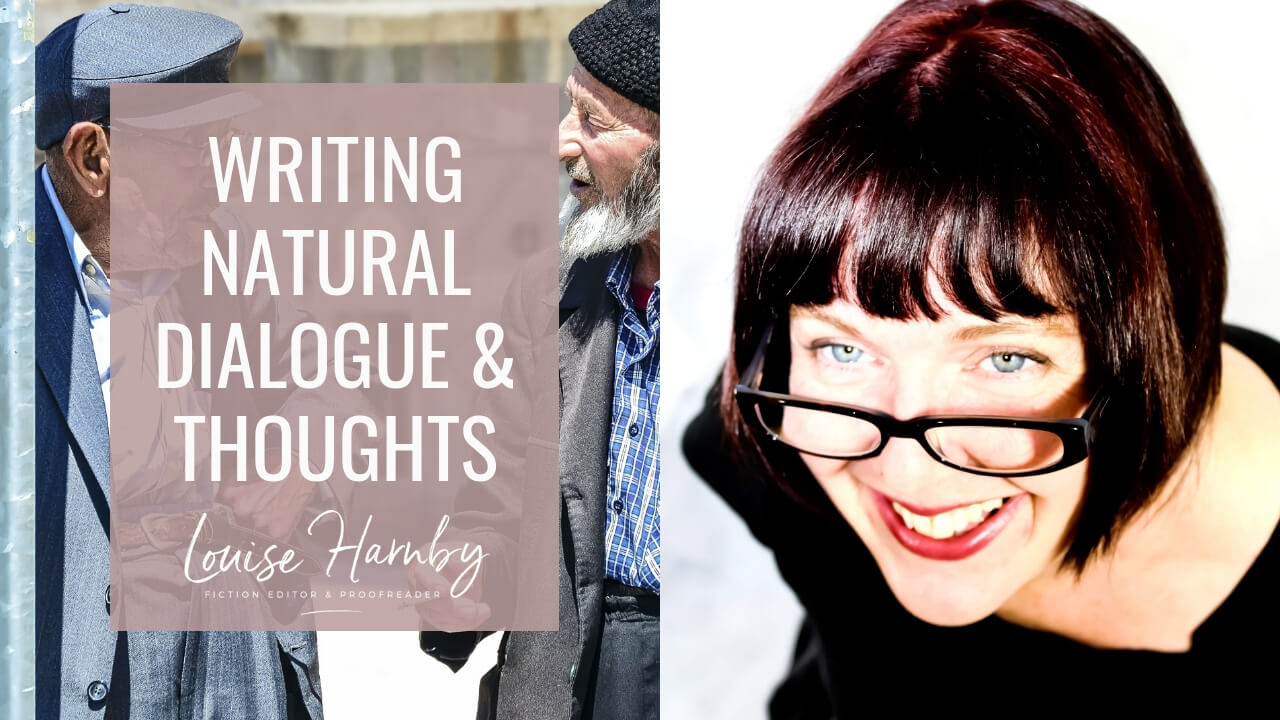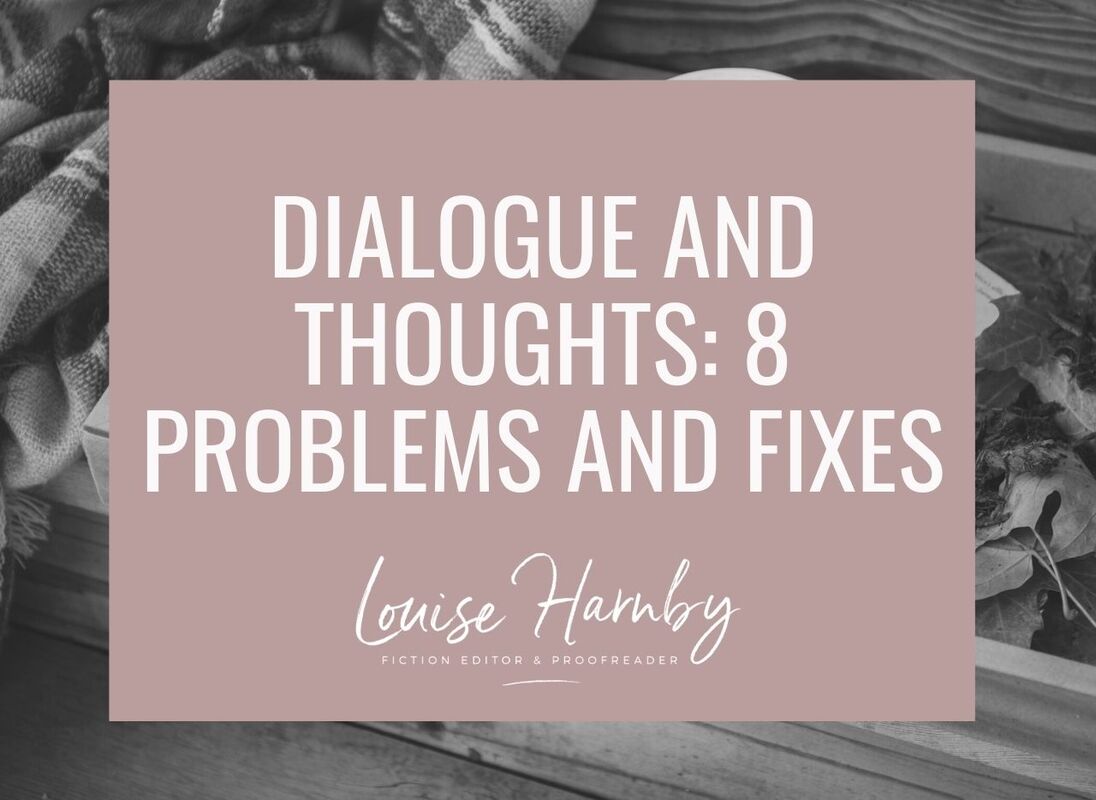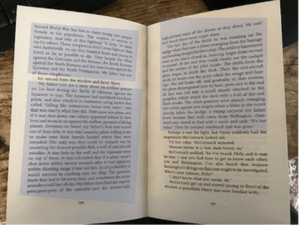|
Powerful dialogue and thoughts enrich a story without the reader noticing. When done poorly they distract at best and bore at worst. Here are 8 problems to watch out for, and ideas about how to solve them.
Problem 1: Maid-and-butler dialogue
Is one of your characters telling another something they already know just so you can let your reader access backstory? If so, you’ve written maid-and-butler dialogue. It’s a literary misfire and should be avoided. Here's an extreme example:
‘Hi, Jenny! It’s good to see you after your three years at Nottingham University. Bet you’re delighted with that first-class honours degree in archaeology.’
‘Thanks. Yeah, I’m thrilled to bits, though there have been times when I’ve yearned for your nine-to-five job as an editor in a small fiction publishing company on the outskirts of Norwich.’ SOLUTIONS
‘Hi, Jenny! Good to see you. Been a while.’
Three years in fact. Clever Jen had notched up a first in archaeology from Nottingham Uni while I was inching my way up the publishing ladder with a small fiction press on the outskirts of Norwich. ‘Yup,’ she said. ‘Seems like an age. How’s tricks in the world of business? Found the next Booker Prize winner yet?’ Problem 2: Real but mundane The conversations many of us have in real life are deathly boring. Here’s one I had recently:
‘Fancy a brew?’
‘Yes, please. Coffee please. Er, or tea. Um, whatever you’re having. As long as it’s wet and warm.’ ‘I’m having coffee but I’m happy to make you tea.’ ‘No, erm, coffee’s perfect. Thanks.’ ‘Milk and sugar?’ ‘Just milk. No sugar, thanks.’ ‘Okay.’ ‘Cheers.’ ‘Um, can I use your bathroom?’ ‘Of course you can. There’s extra loo roll in the cabinet if you need it.’ It’s realistic, certainly, but has no place in a novel. Most of the words are a waste of space, and the trees that were felled to create the paper on which they’re written deserve better. Dialogue needs to be natural, but not too natural. The best dialogue is a hybrid of the real and the contrived, ‘a kind of stylised representation of speech’ as Nicola Morgan calls it in Write to be Published (p. 151). SOLUTIONS
Problem 3: Written accented dialogue It can be tempting to convey accents with phonetic spellings, as in these appalling examples below:
‘Zis cannot be ’appening. Zer family would sinc it unacczeptable.’
‘Ve have vays of getting vat ve vant.’ There are so many problems with this approach that I recommend you avoid it altogether. Bear in mind that dialogue tells us what words have been spoken, not how they’re spelled. Phonetic spelling can turn dialogue into pastiche, and offensive pastiche at that. It’s also difficult to absorb and distracts readers from your story. SOLUTIONS
Problem 4: Troublesome tags The function of speech tags is to tell the reader who’s speaking. They shouldn’t push the dialogue into the background. Nor should they repeat what the reader knows from the dialogue. Furthermore, the verbs we use to tag the dialogue should be speech-related. Otherwise we end up with a reality crash that jars the reader.
‘That dress looks ridiculous,’ guffawed Marie.
‘Come here. Let me show you how it works,’ demonstrated Jonathan. ‘I swear I’ll stick this knife where the sun doesn’t shine if you don’t give me the letter,’ brandished Marcus. SOLUTIONS
Problem 5: Talking heads and monologues Some books can turn into podcasts on the page when dialogue isn’t grounded in the physical environment. Too much dialogue can make the reader feel dissociated from the story, as if the characters are talking in the cloud. In Jo Nesbo’s The Bat, McCormack starts talking on p. 249. On p. 250, Nesbo introduces one line of movement: ‘He turned from the window and faced Harry.’ Then McCormack’s off again. He doesn’t stop talking until p. 251. It’s a monologue in which Hole, the viewpoint character, seems to be nothing more than a receptacle for McCormack’s ear bending. There’s a little bit of back and forth with Hole, plus some action beats in the lower third of p. 251, but then McCormack’s off again for all of p. 252 and the top third of p. 253. The blue highlights show how much of these four pages are taken up with just one character’s speech.
Perhaps it’s deliberate, a way of showing that McCormack’s feeling jaded, worn down by the business of policing. Plus, Jo Nesbo has a big enough fan base to get away with this. However, for the writer who’s building readership, lengthy passages of speech that aren’t grounded in their environment could turn into snooze-fests.
SOLUTIONS
Problem 6: ‘Too many vocatives, Louise.’ The vocative case enables the writer to indicate who’s being spoken to in dialogue. In a bid to avoid speech tagging, some less experienced writers overuse vocatives, which renders the speech unnatural. Next time you get the opportunity to listen to a conversation between two people, notice how often they use each other’s names. You might find they don’t, other than for emphasis. Overuse can labour dialogue, as this example illustrates:
‘Louise, did you murder the sheriff?’
‘I didn’t murder anyone, Johnny. And I’m gutted that you felt the need to even ask that question.’ ‘I’m sorry, Louise, but it’s standard procedure.’ ‘Johnny, you don’t really think I could’ve done that, do you? ‘Not for a second, Louise. Just playing by the rules.’ The exception is dialogue between ranking officers or titled people and their staff. Omitting the sir, Your Lordship, Your Majesty, milady and the like would be unrealistic:
‘Sergeant, how many arrests have been made?’
‘Twelve, sir. We’re expecting two more today.’ ‘Any news on the Merton Street lead?’ ‘Not yet, sir.’ ‘Keep me informed, will you?’ ‘Yes, sir.’ SOLUTIONS
Problem 7: Thoughts in speech marks Speech marks (or quotation marks) have one function – to show the reader that a character is speaking out loud. While some recognized style guides allow for the use of speech marks to indicate thoughts, most professional editors and experienced writers don’t recommend this method because it’s confusing. Some authors might be tempted to use a different speech-mark style to indicate a thought. Again, this is confusing. Your reader might assume that you’ve not edited for consistency. Here’s an example in which dialogue and thought have become muddled:
“Jackson, put that gun down. You’ll hurt someone.”
“No way. Not until I have some guarantees.” Jackson gripped the weapon and glanced left then right. He was surrounded by agents, all of them armed to the teeth. ‘Fuck fuck fuck. How the hell am I going to get out of this one?’ he thought. SOLUTIONS
Problem 8: Thinking unlikely thoughts If your character’s in the middle of an escape, a heist, great sex, or a mixed-martial arts smackdown, thoughts need to be handled with care to remain realistic. High-intensity scenes require rapid-fire thoughts otherwise the thinking becomes intrusive and moderates the pace of the action. Here’s an extreme example of how things can go awry:
Fleur dove behind the chair as the wall exploded. She fumbled for the phone, choking on brick dust, and punched a number onto the screen. Pick up, dammit. God, what I wouldn’t give for a hot bath, a long gin and a warm fire. I haven’t taken time off in ages – not since last summer when I went to the Lakes for a couple of weeks. When this is over and done with, I’m going to hunker down and chill for a few months … just me, the dog and a sandy beach.
Gunfire sent her scrambling on her belly for the door. Some writers use a character’s thoughts as a conduit for providing physical description. Take care with this. In reality, it’s rare for us to look in a mirror and notice our brown hair, green eyes or big feet. Instead, we’re more likely to frame those ideas in terms of criticism, appreciation or concern: Compare these two examples:
SOLUTIONS
Summing up ‘Dialogue isn’t a report of everything that characters say. It’s the compelling and noteworthy real-time, purpose-filled talk that plays out in front of the reader,’ writes Beth Hill (p. 157): The same can be said of thoughts. Reality takes a nosedive when it comes to the novel because only a little of what people think and say in real life will drive a story forward. Most of it is dull. Here’s Sol Stein (p. 113): ‘People won’t buy your novel to hear idiot talk. They get that free from relatives, friends, and at the supermarket. […] Some writers make the mistake of thinking that dialogue is overheard. Wrong! Dialogue is invented and the writer is the inventor.’ Invent dialogue and thoughts that show readers what is being felt (emotion) and what is happening (action). Cited sources and other resources
Louise Harnby is a line editor, copyeditor and proofreader who specializes in working with crime, mystery, suspense and thriller writers.
She is an Advanced Professional Member of the Chartered Institute of Editing and Proofreading (CIEP), a member of ACES, a Partner Member of The Alliance of Independent Authors (ALLi), and co-hosts The Editing Podcast.
10 Comments
21/5/2019 01:49:12 am
Hi Louise
Reply
Louise Harnby
21/5/2019 01:56:55 pm
Thanks, Josephine. I have a free booklet on this here https://www.louiseharnbyproofreader.com/uploads/9/5/8/7/9587442/levels-editing-booklet-251018.pdf but Denise Cowle and I also addressed the issue in The Editing Podcast if you fancy listening: https://www.louiseharnbyproofreader.com/blog/the-editing-podcast-season-1-episode-1-the-different-levels-of-editing
Reply
Lindsey Russell
28/5/2019 08:57:29 pm
My cosy crime WIP is very dialogue driven and at times I get very annoyed with myself that I can't seem to slip in action beats or internal thoughts. I think it stems from a subconscious reluctance to break up a conversation were the two main characters are exchanging ideas on what might have happened and discussing whether it fits with what they know happened. Since they are telling each other what they are thinking internal thought (and I use it a lot where appropriate) seems superfluous during such quick-fire exchanges. I think I'm struggling to put in action beats that actually mean something instead of being put there for the sake of it. Or am I over thinking it in that these actions don't have to mean anything? I'm about to rewrite a page of informative dialogue for the eighth (or possibly ninth) time so any suggestions on how to break free from what I fear is becoming a closed mindset would be most welcome :)
Reply
Louise Harnby
28/5/2019 09:25:58 pm
I wonder if you're overthinking it, Lindsay. You kind of answered your own question! If you think the action beats would be there for the sake of it, and aren't adding anything, they should probably be omitted. You'll enjoy next week's article on dialogue. In it, I talk about how great dialogue doesn't necessarily need narrative because it's infused with voice, mood and intent ... what John Yorke calls character in action through speech, or words to that effect. I give a couple of examples of what I think is effective dialogue in commercial fiction, with Yorke's framework in mind. In one case in particular, there's just quick-fire dialogue that gives the reader everything they need. If you want to see the draft (that's currently being checked by a fresh set of eyes before publication), email me and I'll send it to you so you can reassure yourself.
Reply
Louise Harnby
28/5/2019 09:33:06 pm
Oh, and one thing I forgot to mention above. You raised a really good point about interrupting a conversation. Action beats can, in some cases, slow the pace, and if your intention is to ramp up the drama they'll get in the way. Again, it really comes down to author style. I think, in light of your comment, I'll add a little paragraph into the dialogue post (and into the action beats one) about when these interruptions might be inappropriate.
Lindsey Russell
28/5/2019 09:33:20 pm
Oh yes please - will be most grateful. How do I email you without my email showing on here?
Louise Harnby
28/5/2019 09:33:52 pm
And I misspelled your name both times, LindsEy. So so sorry!
Reply
Louise Harnby
28/5/2019 09:35:21 pm
[email protected]. Or you can use the Contact form on this website!
Reply
29/5/2019 01:33:19 am
This is a really useful post. Thanks. I will be linking to this on my blog.
Reply
Louise Harnby
29/5/2019 07:49:15 pm
Cheers, Rosi!
Reply
Leave a Reply. |
BLOG ALERTSIf you'd like me to email you when a new blog post is available, sign up for blog alerts!
TESTIMONIALSDare Rogers'Louise uses her expertise to hone a story until it's razor sharp, while still allowing the author’s voice to remain dominant.'Jeff Carson'I wholeheartedly recommend her services ... Just don’t hire her when I need her.'J B Turner'Sincere thanks for a beautiful and elegant piece of work. First class.'Ayshe Gemedzhy'What makes her stand out and shine is her ability to immerse herself in your story.'Salt Publishing'A million thanks – your mark-up is perfect, as always.'CATEGORIES
All
ARCHIVES
July 2024
|
|
|
|



















 RSS Feed
RSS Feed





